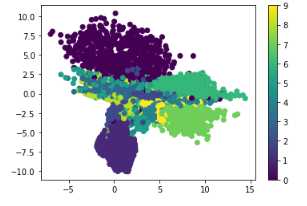莫烦大大keras的Mnist手写识别(5)----自编码
一、步骤:
-
导入包和读取数据
-
数据预处理
-
编码层和解码层的建立 + 构建模型
-
编译模型
-
训练模型
-
测试模型【只用编码层来画图】
二、代码:
1、导入包和读取数据
#导入相关的包 import numpy as np np.random.seed(1337) # for reproducibility from keras.datasets import mnist from keras.models import Model #采用通用模型 from keras.layers import Dense, Input #只用到全连接层 import matplotlib.pyplot as plt #读取数据 (X_train, _), (X_test, y_test) = mnist.load_data()
2、数据预处理:将28*28维度的数据拉成一个向量784,原数据X_train的shape为(60000,28,28),转成x_train(60000,784)。
x_train = X_train.astype('float32') / 255. - 0.5 # minmax_normalized x_test = X_test.astype('float32') / 255. - 0.5 # minmax_normalized x_train = X_train.reshape((x_train.shape[0], -1)) x_test = X_test.reshape((x_test.shape[0], -1)) print(x_train.shape) #(60000, 784) print(x_test.shape) #(10000, 784) print(X_train.shape) # (60000, 28, 28)
3、编码层和解码层的建立+构建模型
# in order to plot in a 2D figure encoding_dim = 2 # this is our input placeholder input_img = Input(shape=(784,)) # encoder layers编码层 encoded = Dense(128, activation='relu')(input_img) encoded = Dense(64, activation='relu')(encoded) encoded = Dense(10, activation='relu')(encoded) encoder_output = Dense(encoding_dim)(encoded) # decoder layers解码层 decoded = Dense(10, activation='relu')(encoder_output) decoded = Dense(64, activation='relu')(decoded) decoded = Dense(128, activation='relu')(decoded) decoded = Dense(784, activation='tanh')(decoded) #构建模型 #包括编码层也包括解码层 autoencoder = Model(input = input_img,output = decoded) #只包括编码层 encoder = Model(input = input_img,output = encoder_output)
4、编译模型
#编译模型
autoencoder.compile(optimizer='adam', loss='mse')
5、训练模型【编码和解码一起训练】
autoencoder.fit(x_train, x_train, epochs=20, batch_size=256, shuffle=True)
6、测试模型并画图显示【仅用编码来预测2维的特征空间】
encoded_imgs = encoder.predict(x_test) plt.scatter(encoded_imgs[:, 0], encoded_imgs[:, 1], c=y_test) #c表示颜色维度 plt.colorbar() plt.show()


 浙公网安备 33010602011771号
浙公网安备 33010602011771号